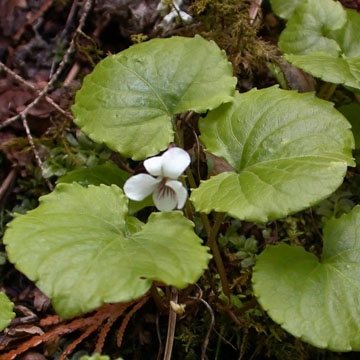

Viola renifolia - (image 1 of 3)
Taxonomy
Family: Violaceae
Habitat
Cool, damp, mossy woodlands, ravines, cedar swamps, usually in calcareous regions.
Associates
Distribution
Newfoundland west to British Columbia, south to MA, CT, NY, MI, MN, and CO.
Morphology
Acaulescent perennial from a thick fleshy rhizome, stolons not produced. Leaf blades unlobed, reniform to ovate or broadly ovate or orbiculate, cordate to broadly cordate at the base, margins serrate-crenate, acute, obtuse, or rounded at the apex. Sepals lanceolate to ovate, usually eciliate, auricles 1-2 mm; petals white, lower three purple-veined, usually all beardless or lower three sparesly bearded, spur petal 0.8-1 cm, spur white, 2-3 mm; capsule ovoid to ellipsoid, 5-8 mm, glabrous; seeds mottled beige to bronze, 1.5-2.2 mm.
Notes
Flowers late April to May
Wetland indicator: FACW
Similar to V. blanda and V. macloskeyi which have leaves about as long or longer than wide and produce stolons in the summer.
References
Haines, A. 2011.
Flora Novae Angliae: a manual for the identification of native and naturalized
higher vascular plants of New England. Yale University Press, New Haven, CT.
Little, R.J. and
L.E. McKinney. 2015. Viola. In: Flora of North America North of
Mexico, Vol. 6. Oxford University Press, New York and Oxford.
USDA, NRCS. 2002. The PLANTS Database, Version 3.5 (http://plants.usda.gov).
National Plant Data Center, Baton Rouge, LA 70874-4490 USA.
|
Michael Hough © 2017 |